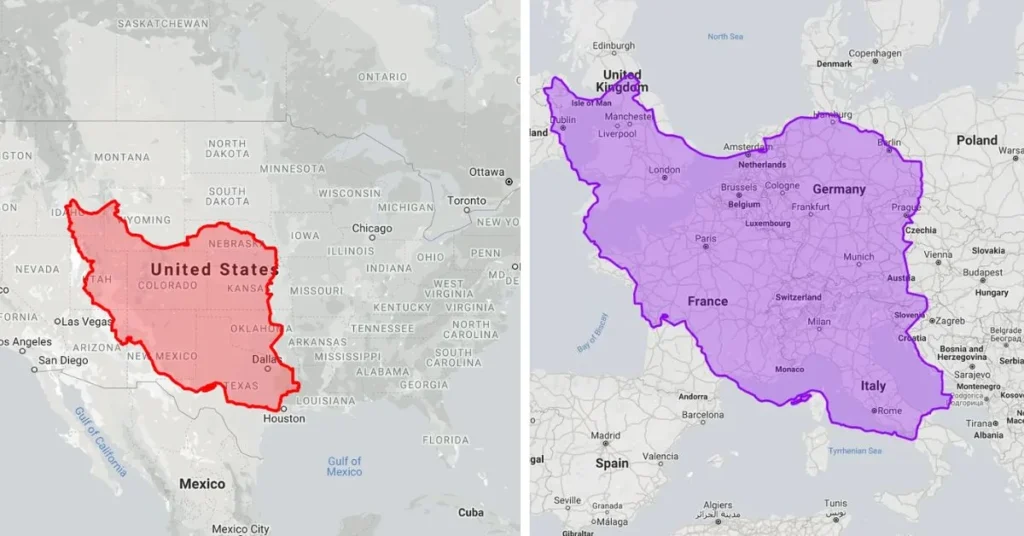Introduction to Iran and Pennsylvania
When it comes to geographical size, many people often find themselves puzzled. How do vast countries compare with smaller states? Take Iran and Pennsylvania, for example. Iran is a country steeped in history and rich culture, while Pennsylvania boasts its own unique charm as one of the original thirteen colonies in the United States. But just how big is Iran compared to Pennsylvania? Buckle up as we explore this intriguing comparison through maps, numbers, and fascinating facts that reveal not just size but also insights into their populations, cultures, economies, and political landscapes.
Geographical Comparison of Size
Iran is a vast country located in the Middle East, covering around 1.65 million square kilometers. This makes it one of the largest nations in the region.
In contrast, Pennsylvania occupies about 119,283 square kilometers. While it’s one of the bigger states in the U.
S., it’s dwarfed by Iran’s sheer size.
To visualize this difference, you could fit Pennsylvania into Iran nearly fourteen times. The diverse landscapes of Iran range from deserts to mountains and lush forests, showcasing its rich geography.
Pennsylvania features rolling hills and river valleys but lacks the expansive deserts or rugged terrain found in Iran. Each area presents unique geographical traits that influence climate and biodiversity significantly.
Maps can help illustrate these differences vividly. As we explore further dimensions like population and culture, understanding their sizes lays a foundation for deeper comparisons ahead.
Population Comparison
When considering the population, how big is Iran compared to Pennsylvania present a striking contrast. Iran is home to approximately 85 million people. This makes it one of the most populous countries in the Middle East.
In stark comparison, Pennsylvania’s population hovers around 13 million. The difference is quite remarkable. It highlights not only size but also density in living conditions.
Iran’s diverse demographics reflect various ethnic groups, languages, and cultures. This adds richness to its societal fabric.
Pennsylvania showcases a mix of urban and rural populations primarily centered around cities like Philadelphia and Pittsburgh.
Such demographic variations influence cultural dynamics significantly across both regions. While Iran grapples with rapid urbanization challenges, Pennsylvania focuses on maintaining its historical roots amidst modern growth trends.
Cultural Differences and Similarities
Iran and Pennsylvania boast rich cultural tapestries, yet their threads are woven from distinct patterns. In Iran, ancient traditions blend seamlessly with modern influences. Persian poetry, art, and cuisine reflect a history that spans millennia.
Conversely, Pennsylvania’s culture is shaped by its diverse immigrant roots. From Amish communities to urban centers like Philadelphia, the state showcases a variety of lifestyles and customs.
Despite these differences, both places share a deep respect for family values and community ties. Hospitality shines in Iranian homes as guests are treated with exceptional warmth—much like the welcoming spirit found in small-town Pennsylvania.
Festivals also reveal common ground; Iranians celebrate Nowruz (the Persian New Year), while Pennsylvanians revel during local fairs or holidays rooted in their heritage. These exchanges highlight how cultures can be uniquely different yet strikingly similar at heart.
Economic Factors
Iran’s economy is diverse but heavily relies on oil exports. The country possesses some of the largest reserves in the world, shaping its financial landscape.
In contrast, Pennsylvania boasts a mixed economy rooted in manufacturing, agriculture, and services. Its rich natural resources also include coal and natural gas.
The two regions experience vastly different economic challenges. Iran faces international sanctions that impact trade and investment opportunities. Meanwhile, Pennsylvania navigates fluctuations in industry demands and labor market shifts.
Job growth trends differ significantly as well. Iran struggles with high unemployment rates among youth while Pennsylvania benefits from a skilled workforce adapting to new technologies.
This vibrant mix creates distinct economic environments influenced by local resources, governance structures, and global market interactions.
Political Climate
Iran’s political climate is shaped by a complex interplay of history, religion, and ideology. The country operates under an Islamic Republic system where the Supreme Leader holds significant authority over both government and military. This centralized power influences domestic policies and international relations.
In contrast, Pennsylvania functions within a democratic framework. Elected officials represent citizens’ voices in decision-making processes, from local governance to state-wide matters. Political parties thrive here, fostering diverse viewpoints.
Tensions often arise in Iran due to strict regulations on freedom of expression and assembly. Citizens face challenges when advocating for change or reform.
Pennsylvania enjoys more civil liberties with active participation encouraged among its residents. Campaigns are vibrant and reflect a wide spectrum of opinions.
These differences create distinct atmospheres that affect how politics is experienced daily in each region.
Conclusion
When comparing the sizes of Iran and Pennsylvania, it’s clear that the two are vastly different in scale. Iran, with its expansive land area of approximately 1.65 million square kilometers, dwarfs Pennsylvania’s modest size of about 119 thousand square kilometers.
Population dynamics further highlight these differences; Iran is home to over 83 million people, while Pennsylvania boasts a population nearing 13 million. The cultural landscapes also diverge significantly, reflecting unique histories and traditions.
Economically, both regions display strengths rooted in their resources and industries but operate on entirely different scales due to their size disparities. Political climates vary greatly between the two areas as well—reflecting local governance structures and international influences.
So when asking how big is Iran compared to Pennsylvania? It’s evident that Iran stands out as much larger not only geographically but also demographically and politically.
For more insights into financial trends and updates, check out AGGR8Finance’s latest financial news







